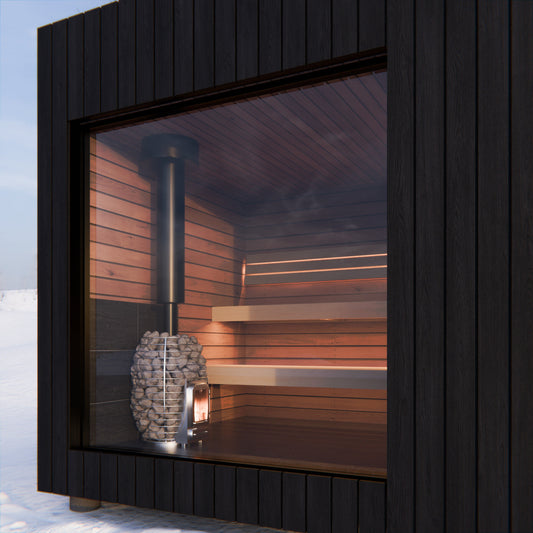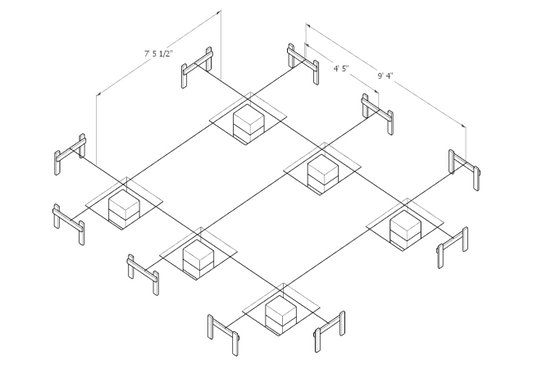
12 things to consider before building your outdoor sauna
If you are planning to build your own outdoor sauna, these tips will give you a heads-up on what to look out for. It is essential to consider all those aspects so that you don’t end up disappointed by a small thing you missed in the planning stage.
1. What is the ground type at your build site?
Every site is different. Some will have sand, others clay, or rock. Ground type will determine the type of suitable foundations. Research what the proper foundation type is for the site you are planning to build. The most sure way is to get a test hole dug and analyzed by a geology specialist. Then speak to a local civil engineer to determine the right type of foundation. This applies mainly to larger and heavier saunas. If you are building a small 7’x7’ sauna (2x2m), you should be fine with concrete blocks placed in a sand, gravel, or cement mixture and leveled. Siteprep.com has a good article on different types of foundations for sheds, and it applies to saunas too.
2. Are you fine with having steps into the sauna?
If you go with a foundation type that elevates your sauna above the ground, you will need to have a few steps up to the sauna. If you don’t want steps, you will need to level the ground and choose a foundation type that is suitable for your needs (poured slab, crushed gravel, etc.)
3. How will you approach the building?
The approach will determine where the door should be. Also, if the approach is from a higher ground, the building will be visible from above. You may then consider a different roof covering or a green roof.
4. What is the slope of the ground?
If the ground is very sloped, you will need to level the land or adjust the foundations to accommodate that. Never put ‘fresh’ soil where the sauna will be. Fresh soil will settle over time. An alternative is using ground screws or pier foundations.
5. Do you have access to the electrical grid?
If you want an electric heater, you will ideally want a three-phase connection. The cable thickness should be chosen by an electrician. If you want to build an off-grid sauna, you can install a wood heater and solar panels with a battery for light.
6. Do you have access to Wi-Fi nearby or an Ethernet cable?
With an electric sauna heater, you can get a Wi-Fi enabled heater controller, so you can turn on your sauna heater remotely. You will need a Wi-Fi signal or an Ethernet cable. For Wi-Fi, check the signal with your phone. Remember that the Aluminium-paper screen blocks the Wi-Fi signal, so place the Wi-Fi receiver in a spot that isn’t affected. If your sauna is more than 30 or so steps from the router, consider running an Ethernet cable. Ethernet cables can be as long as 100m (320’) without signal loss.
7. Are there any views that you want to capture?
If you have a lakeside property or a spot with perfect views, you will definitely want a sauna with big windows. Position your sauna to take advantage of those views.
8. What finish material do you want for the inside of your sauna?
Finish materials (usually wood) differ by physical properties, smell, durability, appearance, and, of course, cost. In Northern America, Cedar is very common. It has a strong smell and is visually pretty. In Europe, Pine and Spruce are very common for sauna interiors. Both Pine and Spruce will have some knots, and Spruce will have some sap in it. Sap gives off a nice small, but is generally undesirable because it can drip when hot. Make sure you select the ‘A’ grade wood. It means the highest quality with little knots and sap.
9. Does the sauna need to be wheelchair accessible?
If your sauna is to be used by a wheelchair user, you will want to avoid steps, and any elevation change has to be gentle. You can also think about handrails, making the sauna room larger for the 1400mm turning circle of a wheelchair. You can get a bench that can be lowered and then hoisted up for the disabled person to enjoy the heat.
10. Is DIY a possibility, or will you get a contractor?
Take a realistic look at your skills, and your tools. Do you have what it takes? A sauna has a medium level of project difficulty for an average person. I recommend having at least one person with some construction experience helping you. It makes the whole process less frustrating and much faster. We’ve also had customers with zero construction experience who successfully built their sauna with our plans, so don’t get discouraged.
11. Do you need planning permission?
Check with your local authorities if you need planning permission. In most countries, you do not need permission. Make sure there are no legal limitations. If in doubt, speak to a local architect.
12. What style do you want your sauna to have?
It’s best to reference local traditional architecture if you don’t have your own preference. If you like a particular style, then, of course, go with it. Possibilities are: modern, Scandinavian, traditional, Japanese, and minimalist. If you want a custom design, reach out to us!
Is anything missing from this list? Let us know in the comments below.





